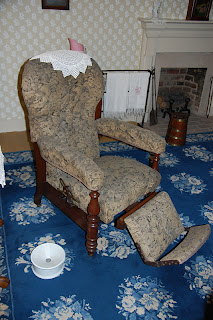A paved road dramatically altered the appearance of the gap in the middle part of this century. In an effort to restore its historic appearance and also cut down on traffic fatalities on the curvy, dangerous road, a tunnel was dug beneath the Gap, opening in 1996. Now 15 years later, it's evident that the tunnel achieved success in both goals: it looks quite similar to what early pioneers saw in their westward journey, and traffic fatalities that used to number upwards of seven per year are nearly non-existant: just three since it opened.
A feature at the Gap's summit, once used as a landmark for travelers, is known by the original name of Gap Cave. We toured it today with Ranger Brittany, a very kind ranger-in-training from the Kentucky side of the Gap. She equipped us with flashlights and then lead us into the cave, pointing out various species of bat, as well as incredible rock formations. Her Kentucky "twang" is quite strong, and she laughlingly informed us that columns in the cave are never called "pillars," as that's what you put your head on to sleep!
After our cave adventure, we drove back through (or rather under) the gap into Tennessee, heading east to Greeneville, home of our 17th President, Andrew Johnson. His task was monumental: reuniting the nation and helping the country grieve and move on following the assissination of Lincoln. Johnson, a man with no formal education, made his pre-politics living as a tailor, teaching himself to read and write in the evenings, and keeping up on current events through the assistance of hired "readers" in his tailor shop.
He worked his way up the political channels, serving as alderman, mayor, state legislator and senator, Congressman, and governor. A staunch supporter of the Union, he rallied against the state's secession. He revered the Constitution and had the respect of many in the Lincoln administration, in spite of the fact that he was a Democrat. Lincoln appointed him military governor in Tennessee during the Civil War, and Johnson emancipated the state's slaves in 1864 (the state was not subject to Lincoln's Emancipation Proclamation). He'd freed his own 10 slaves the year before, offering them pay for their jobs should they choose to remain with his family. (They all did.)
When Lincoln began his campaign for reelection, Johnson was tapped as his running mate; it was hoped that his party affiliation, combined with his identity as a Southerner, would broaden the ticket's support. And when Lincoln was killed just five months after winning the election, Johnson continued with the themes and promises on which they'd campaigned. He issued many pardons to leaders of the failed Confederacy, contingent upon their declaration of loyalty to the restored Union. But he did not wish to demand their shame, on which point he and the Republican majority in Congress disagreed. He vetoed many bills in the next three years and became despised by many in D.C. When he fired Secretary of War Edwin Stanton in the face of the recently passed (in an override of Johnson's veto) Tenure of Office Act, his action prompted his impeachment by the House of Representatives. The resulting trial in the Senate lasted six weeks and was attended by ticket-holding crowds seated in the gallery. Johnson was aquitted, but the decision had hinged on a single vote, cast by a senator from Kansas. The two-thirds majority, once a foregone conclusion in the heavily leaning Republican Senate, was thwarted by Johnson's efforts to gain the confidence of seven moderate Republicans.
At the end of his single term, he returned to Greeneville with his family and resumed his activity in local politics. Six years later, in 1875, he returned to D.C. as a senator. But weeks into his term he suffered a massive stroke and died. His legacy is one of conflict, yet today we gained an appreciation of just how much healing and unification was accomplished during his Presidency. He certainly came a long way from his teen years as an illiterate apprentice to a tailor, and for that alone he deserves great respect. He had to step into monumental shoes, and his task of bringing together two halves of nation that had both suffered and inflicted so much damage against each other was nearly impossible. Our knowledge about this controversial figure in our country's history now goes far beyond his headline description of "impeached President."
Photos:
(1) The Gap, in the foreground
(2) on the Boone trail leading to the cave
(5) The girls loved having their own powerful flashlights!
(6) An authentic building identical to Johnson's tailor shop
(7) Modeling girls' fashion in the mid-1800s
(8) Kelsey and Kendall kick back on the porch of the Johnson home
(9) All of the pieces in the home belonged to Johnson. In his bedroom, we saw a signature stamp displayed on his desk; a badly healed injury to his right elbow made writing very difficult, and his spelling (even of his own name) was terrible. A stamp made applying his signature easier for him and more consistent.
(10) Johnson's wife, Eliza, died of turberculosis just six months after his death in 1875. She'd suffered with the disease for decades, and this early version of a Lazy-Boy recliner in her bedroom indicates the severity of her condition rather than an enviable comfort.
(11) One of the bedrooms was used by Johnson's grandchildren and contains some of their toys. This set of logs predates their current identity of "Lincoln Logs." The label on the box says "The Log-Cabin Playhouse."
(13) standing with Andrew Johnson
(14) A beautiful sunset at the end of a great day!
 |
 |
 |
 |
 |
 |
 |
 |
 |
 |




Wow! You really did have a great day!
ReplyDelete